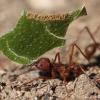It can’t be because of the food. It was probab;y due to heat as their fungus easily dies in even a small fluctuation of temperature either higher or lower.
Heat doesn't kill off the workers as the original post stated - tainted folliage/food on the other hand can and will kill both the fungus and workers. Acromyrmex versicolor workers can go weeks without fungus or longer, so it's extremely unlikely for workers to die out in a huge wave soon after a collapse in fungus volume. The detail of a small temperature fluctuation killing fungus is also erroneous unless the temperature is spiking a few degrees above 80 degrees F. The fungus is able to withstand over a 10 degree drop from 80 degrees F.
I agree. The cause most likely was a bacteria or fungus, as the original poster suggested. Another cause could be pesticides on the leaves that were fed to the ants, but I wouldn’t bet on it.
The heat did rise above 80 but my house has air conditioning though, so if they make a comeback I'm not going to feed them leaves from my backyard anymore
Edit(s) :
I added moisture to their outworld, and for some reason most of the queens have moved there?
Edit 2 : They actually have tiny shreds of fungus! I think that the majority of the fungus may have died because of me taking a (relatively long) vacation. Also, I have no ant keeping friends who can help me when I'm on vacation so that's why.
Edited by ps004ynos, April 17 2024 - 4:49 PM.
![]() . My guess is that the new leaves that I gave them had some bacteria on it. There also was a huge die off of workers
. My guess is that the new leaves that I gave them had some bacteria on it. There also was a huge die off of workers ![]() . The queens are ok for now though (luckily)
. The queens are ok for now though (luckily) ![]()
![]()






















